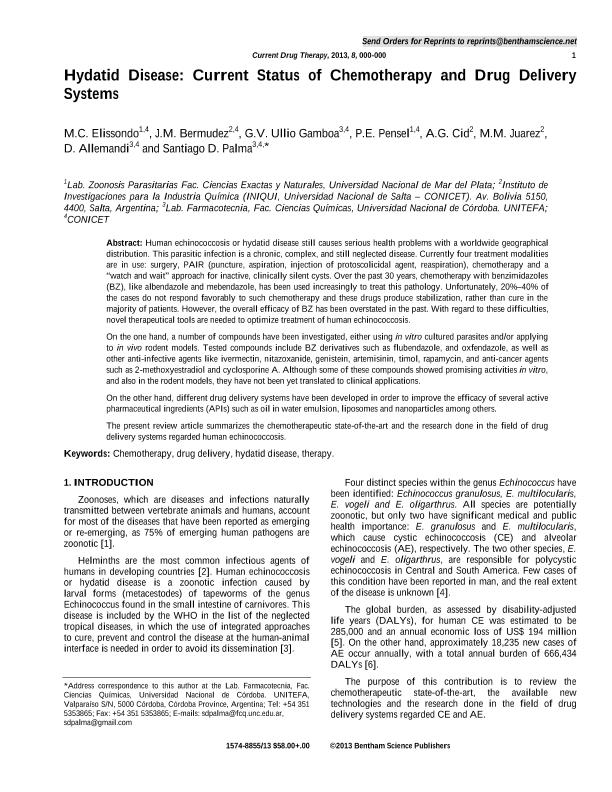Mostrar el registro sencillo del ítem
dc.contributor.author
Elissondo, María Celina

dc.contributor.author
Bermudez, Jose Maria

dc.contributor.author
Ullio Gamboa, Gabriela Veronica

dc.contributor.author
Pensel, Patricia Eugenia

dc.contributor.author
Cid, Alicia Graciela

dc.contributor.author
Juarez, Maria Mercedes

dc.contributor.author
Allemandi, Daniel Alberto

dc.contributor.author
Palma, Santiago Daniel

dc.date.available
2017-02-08T20:46:20Z
dc.date.issued
2013-07
dc.identifier.citation
Elissondo, María Celina; Bermudez, Jose Maria; Ullio Gamboa, Gabriela Veronica; Pensel, Patricia Eugenia; Cid, Alicia Graciela; et al.; Hydatid Disease: Current Status Of Chemotherapy And Drug Delivery Systems; Betham Science; Current Drug Therapy; 8; 3; 7-2013; 197-205
dc.identifier.issn
1574-8855
dc.identifier.uri
http://hdl.handle.net/11336/12726
dc.description.abstract
Human echinococcosis or hydatid disease still causes serious health problems with a worldwide geographical distribution. This parasitic infection is a chronic, complex, and still neglected disease. Currently four treatment modalities are in use: surgery, PAIR (puncture, aspiration, injection of protoscolicidal agent, reaspiration), chemotherapy and a “watch and wait” approach for inactive, clinically silent cysts. Over the past 30 years, chemotherapy with benzimidazoles (BZ), like albendazole and mebendazole, has been used increasingly to treat this pathology. Unfortunately, 20%–40% of the cases do not respond favorably to such chemotherapy and these drugs produce stabilization, rather than cure in the majority of patients. However, the overall efficacy of BZ has been overstated in the past. With regard to these difficulties, novel therapeutical tools are needed to optimize treatment of human echinococcosis.
On the one hand, a number of compounds have been investigated, either using in vitro cultured parasites and/or applying to in vivo rodent models. Tested compounds include BZ derivatives such as flubendazole, and oxfendazole, as well as other anti-infective agents like ivermectin, nitazoxanide, genistein, artemisinin, timol, rapamycin, and anti-cancer agents such as 2-methoxyestradiol and cyclosporine A. Although some of these compounds showed promising activities in vitro, and also in the rodent models, they have not been yet translated to clinical applications.
On the other hand, different drug delivery systems have been developed in order to improve the efficacy of several active pharmaceutical ingredients (APIs) such as oil in water emulsion, liposomes and nanoparticles among others.
The present review article summarizes the chemotherapeutic state-of-the-art and the research done in the field of drug delivery systems regarded human echinococcosis.
dc.format
application/pdf
dc.language.iso
eng
dc.publisher
Betham Science
dc.rights
info:eu-repo/semantics/openAccess
dc.rights.uri
https://creativecommons.org/licenses/by-nc-sa/2.5/ar/
dc.subject
Chemotherapy
dc.subject
Drug Delivery
dc.subject
Hydatid Disease
dc.subject
Therapy
dc.subject.classification
Parasitología

dc.subject.classification
Ciencias de la Salud

dc.subject.classification
CIENCIAS MÉDICAS Y DE LA SALUD

dc.title
Hydatid Disease: Current Status Of Chemotherapy And Drug Delivery Systems
dc.type
info:eu-repo/semantics/article
dc.type
info:ar-repo/semantics/artículo
dc.type
info:eu-repo/semantics/publishedVersion
dc.date.updated
2016-03-10T13:41:47Z
dc.identifier.eissn
2212-3903
dc.journal.volume
8
dc.journal.number
3
dc.journal.pagination
197-205
dc.journal.pais
Emiratos Árabes Unidos

dc.journal.ciudad
Sharjah
dc.description.fil
Fil: Elissondo, María Celina. Universidad Nacional de Mar del Plata. Facultad de Ciencias Exactas y Naturales. Departamento de Biologia. Laboratorio de Zoonosis Parasitarias; Argentina. Consejo Nacional de Investigaciones Científicas y Técnicas; Argentina
dc.description.fil
Fil: Bermudez, Jose Maria. Consejo Nacional de Investigaciones Científicas y Técnicas. Centro Científico Tecnológico Salta. Instituto de Investigación Para la Industria Química (i); Argentina
dc.description.fil
Fil: Ullio Gamboa, Gabriela Veronica. Consejo Nacional de Investigaciones Cientificas y Tecnicas. Centro Cientifico Tecnologico Cordoba. Unidad de Investigacion y Desarrollo En Tecnologia Farmaceutica; Argentina
dc.description.fil
Fil: Pensel, Patricia Eugenia. Universidad Nacional de Mar del Plata. Facultad de Ciencias Exactas y Naturales. Departamento de Biologia. Laboratorio de Zoonosis Parasitarias; Argentina. Consejo Nacional de Investigaciones Científicas y Técnicas; Argentina
dc.description.fil
Fil: Cid, Alicia Graciela. Consejo Nacional de Investigaciones Científicas y Técnicas. Centro Científico Tecnológico Salta. Instituto de Investigación Para la Industria Química (i); Argentina
dc.description.fil
Fil: Juarez, Maria Mercedes. Consejo Nacional de Investigaciones Científicas y Técnicas. Centro Científico Tecnológico Salta. Instituto de Investigación Para la Industria Química (i); Argentina
dc.description.fil
Fil: Allemandi, Daniel Alberto. Consejo Nacional de Investigaciones Cientificas y Tecnicas. Centro Cientifico Tecnologico Cordoba. Unidad de Investigacion y Desarrollo En Tecnologia Farmaceutica; Argentina
dc.description.fil
Fil: Palma, Santiago Daniel. Consejo Nacional de Investigaciones Cientificas y Tecnicas. Centro Cientifico Tecnologico Cordoba. Unidad de Investigacion y Desarrollo En Tecnologia Farmaceutica; Argentina
dc.journal.title
Current Drug Therapy
dc.relation.alternativeid
info:eu-repo/semantics/altIdentifier/url/http://www.ingentaconnect.com/content/ben/cdth/2013/00000008/00000003/art00007
Archivos asociados
